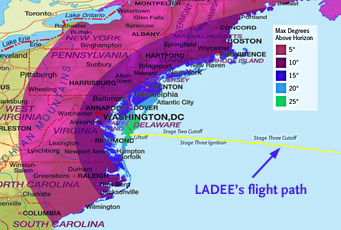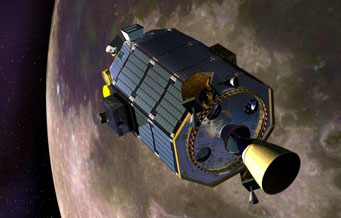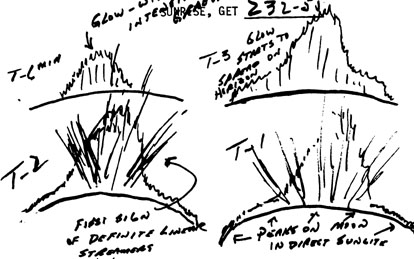For nearly a half century, planetary scientists have been puzzled by tenuous "clouds" of dust hovering over the lunar surface. With observations from a just-launched spacecraft, they finally hope to understand just what's going on.
| Update: At 10:57 Universal Time on October 6th, LADEE fired its onboard rocket for 4 minutes and slowed its velocity enough to be captured into lunar orbit. Flight engineers at NASA's Ames Research Center oversaw the maneuver despite the near-complete shutdown of NASA and other U.S. federal agencies. Additional firings are planned for October 9th and 12th to bring the spacecraft's orbit closer to the lunar surface. |

In the minutes right after LADEE's launch on the night of September 6th, the fiery plume of its rocket became visible from much of the East Coast. Click on the image for a larger view.
Orbital Sciences
Because the spacecraft is relatively small (7.7 feet tall) and compact (844 pounds), mission managers eschewed the usual arrangements at Cape Canaveral in Florida for the economical Mid-Atlantic Regional Spaceport, a commercial launch complex on the Delmarva Peninsula.

An artist's concept of NASA's Lunar Atmosphere and Dust Environment Explorer (LADEE) spacecraft orbiting the Moon.
NASA / Ames Reseach Center / Dana Berry
(Factoids: This was the inaugural launch of the Minotaur V, though all of its engines are flight-proven. In fact, the first three stages use repurposed engines from Peacekeeper intercontinental ballistic missiles.)
For now, LADEE remains in a looping orbit around Earth, and over the next three weeks trajectory tweaks will prepare it for a 5¼-day cruise to the Moon. Once there, a final rocket blast will nudge LADEE into a looping retrograde orbit over the lunar equator. That will be trimmed first to a circular altitude of about 150 miles (250 km), and then to an even lower circuit that at times skims no more than 12 miles (20 km) from the lunar surface.
Only then can it begin making the observations that mission scientists hope will explain a perplexing lunar phenomenon that has stumped them for decades.

A photo of a low-level glow along the lunar horizon just after sunset, as recorded in January 1968 by Surveyor 7.
NASA
First seen by the Surveyor 7 lander in 1968 and later by Apollo astronauts, clouds of fine dust sometimes levitate above the lunar surface. Since these localized "flurries" occur at dawn and dusk, researchers have speculated that some kind of static charging might be involved. But the true cause remains unknown.

Sketches made in December 1972 by Apollo 17 astronaut Eugene Cernan show streamers seen just before sunrise as seen from lunar orbit (though spacecraft was over the Moon's sunset terminator at the time).
NASA
LADEE will use its ultraviolet spectrometer and neutral mass spectrometer to analyze the ultra-tenuous wisps of gas hovering over the Moon. This exosphere probably arises due to the continual bombardment of the lunar surface and is likely rich in helium (derived from solar-wind ions trapped on grain surfaces) and argon (produced by the decay of radioactive potassium in the lunar crust).
Meanwhile, the Lunar Dust Experiment will sweep up high-flying motes as small as 2 microns across. After striking the instrument's hemispherical target, they'll vaporize into tiny clouds of ions and electrons that reveal the particles' mass and composition.
NASA managers don't intend to extend the $248 million mission beyond its 100-day-long science operation. Instead, plans call for the spacecraft to be pushed out of its orbit and forced to crash into the lunar surface.
For lots more about the spacecraft and its mission, check out the detailed LADEE press kit.
 1
1









Comments
Greg Redfern
September 7, 2013 at 7:10 pm
From Wallops Island
https://www.youtube.com/watch?v=dVz9uW8-86A
Enjoy!
Sky Guy Greg Redfern
You must be logged in to post a comment.
You must be logged in to post a comment.